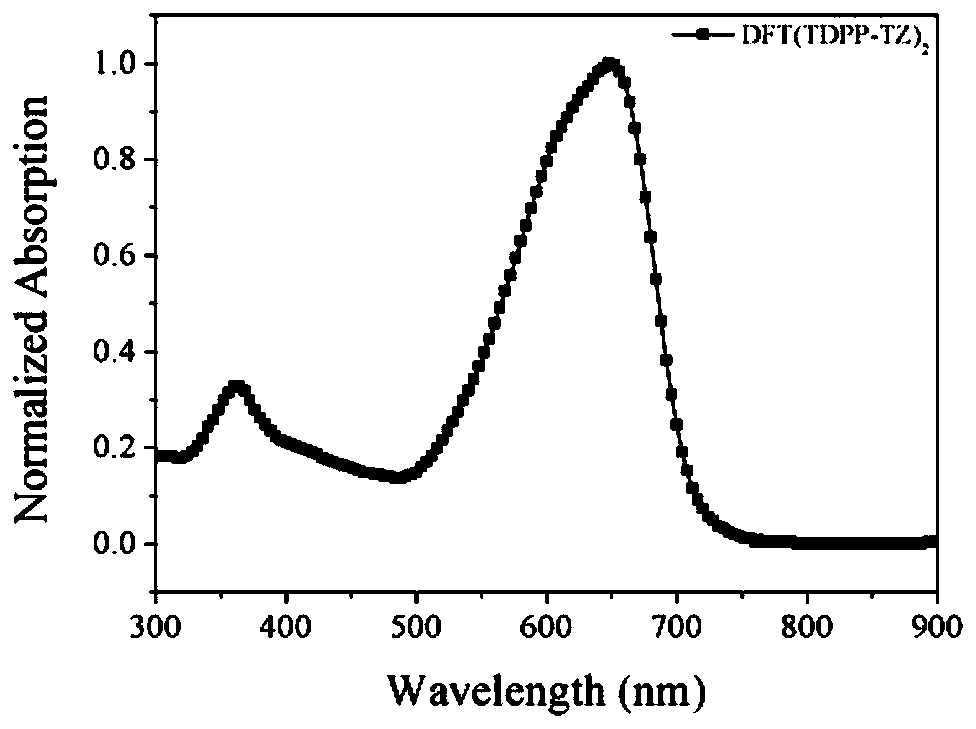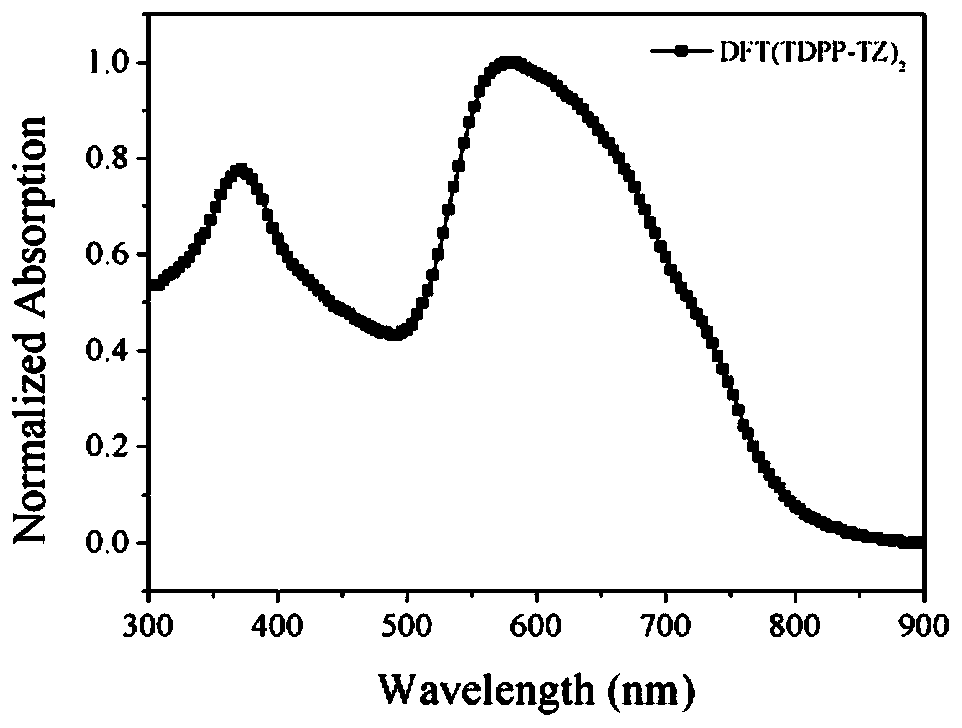Alkyl/sulfanyl N-heterocyclic terminal D (A-Ar) type 2 conjugate compound as well as preparation method and application thereof
A technology of conjugated compound and sulfanyl nitrogen is applied in the field of D2-type conjugated compound and its preparation, which can solve the problems of low photoelectric conversion efficiency, hinder the development of high-efficiency organic small molecule solar cells, etc., and achieve high energy conversion efficiency, The effect of high hole mobility
- Summary
- Abstract
- Description
- Claims
- Application Information
AI Technical Summary
Problems solved by technology
Method used
Image
Examples
Embodiment 1
[0060] Embodiment 1, compound 2-octylthiazole (TZR 1 ) synthetic route is as follows:
[0061]
[0062] Under nitrogen protection, in a 100mL three-necked flask, dissolve 2-bromothiazole (6.0g, 36.58mmol) with dry ether, add dropwise 2.5M n-butyllithium (16.0ml, 40.24mmol) at -78°C, -78 After reacting at ℃ for two hours, n-octane bromide (7.0 g, 36.58 mmol) was added all at once, and after keeping the reaction for half an hour, it was turned to room temperature for overnight reaction. The solvent was directly spin-dried under reduced pressure to obtain a light yellow liquid, which was separated by column chromatography using petroleum ether as an eluent to obtain the product (TZR 1 ) 6.0 g, yield 84%. 1 H NMR (500MHz, CDCl 3 )δ7.66(d,J=3.3Hz,1H),7.18(d,J=3.3Hz,1H),3.05–2.97(m,2H),1.79(dt,J=15.4,7.6Hz,2H), 1.33–1.26(m,11H),0.87(s,3H).
Embodiment 2
[0063] Example 2,2-octylthiazole-5-tributyltin (SnTZR 1 ) The synthetic route is as follows:
[0064]
[0065] Under nitrogen protection, in a 100mL three-necked flask, dissolve 2-octylthiazole (2.46g, 10.8mmol) in dry tetrahydrofuran, add dropwise 2.5M n-butyllithium (4.75ml, 11.88mmol) at -78°C, - After two hours of reaction at 78°C, tributyltin chloride (3.22ml, 11.88mmol) was added in one go, and after half an hour of incubation, the reaction was carried out at room temperature overnight. The solvent was directly spin-dried under reduced pressure to obtain light yellow thick liquid (SnTZR 1 ), used directly in the next reaction. 1 H NMR (400MHz, CDCl 3 )δ7.58(s,1H),3.06–3.03(m,2H),1.80(dt,J=15.0,7.4Hz,2H),1.58–1.51(m,6H),1.46(dt,J=16.1, 8.7Hz, 6H), 1.39-1.17(m, 22H), 0.89(t, J=7.2Hz, 12H).
Embodiment 3
[0066] Example 3, 3-(5-bromo-2-thienyl)-2,5-bis(2-ethylhexyl)-6-(5-(2-octyl-5-thiazolyl)-2-thiophene base) diketopyrrolopyrrole (BrTDPP-TZR 1 ) synthetic route is as follows:
[0067]
[0068] Under nitrogen protection, add 20mL of toluene, 2-octylthiazole-5-tributyltin (286mg, 0.59mmol), 3,6-bis(5-bromo-2-thienyl)-2,5- Bis(2-ethylhexyl)-diketopyrrolopyrrole (400 mg, 0.59 mmol), tetrakistriphenylphosphine palladium (34 mg, 0.03 mmol). Stir and heat to 80°C under nitrogen atmosphere, stop the reaction after 4h, and cool to room temperature. The solvent was removed by rotary evaporation, and the mixed solution of sherwood oil / dichloromethane volume ratio of 5:1 was used as the eluent to carry out column chromatography separation to obtain the product (BrTDPP-TZR 1 ) 172 mg, yield 30.0%. 1 H NMR (400MHz, CDCl 3)δ8.90(d, J=4.1Hz, 1H), 8.64(d, J=4.2Hz, 1H), 7.84(s, 1H), 7.27(s, 1H), 7.23(d, J=4.2Hz, 1H), 3.98(dt, J=13.7, 7.2Hz, 4H), 3.02(t, J=7.7Hz, 2H), 1.82(dt, J=15.3, 7...
PUM
| Property | Measurement | Unit |
|---|---|---|
| thickness | aaaaa | aaaaa |
| decomposition temperature | aaaaa | aaaaa |
Abstract
Description
Claims
Application Information
 Login to View More
Login to View More - R&D
- Intellectual Property
- Life Sciences
- Materials
- Tech Scout
- Unparalleled Data Quality
- Higher Quality Content
- 60% Fewer Hallucinations
Browse by: Latest US Patents, China's latest patents, Technical Efficacy Thesaurus, Application Domain, Technology Topic, Popular Technical Reports.
© 2025 PatSnap. All rights reserved.Legal|Privacy policy|Modern Slavery Act Transparency Statement|Sitemap|About US| Contact US: help@patsnap.com



